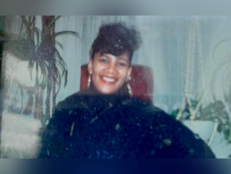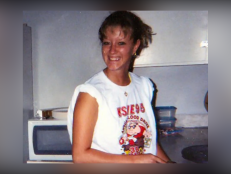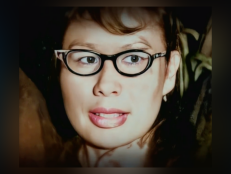An Arizona Woman Was Brutally Murdered At Her Job. Her Accused Killer Was Exonerated After 10 Years Behind Bars.
Kim Ancona was found dead at a Phoenix restaurant in 1991, and detectives zeroed in on Ray Krone after his name was found in her address book.

Warner Bros. Discovery, Inc. (Screenshot from ID's "Crime Scene Confidential")
An Arizona man convicted of killing a mother, who was recently divorced and trying to get back on her feet, proclaimed his innocence from death row. It would take over a decade for him to prove he was telling the truth.
On Dec. 29, 1991, the owner of CBS Restaurant and Lounge in Phoenix found night manager Kim Ancona dead just after 8 a.m. on the floor of the establishment’s men’s restroom.
Ancona, 36, was nude and lying in a pool of blood. She had been stabbed six times — once in the back and five times in the neck area — and brutally sexually assaulted with a wooden doorstop. “She really suffered in a very painful type of way,” says former defense attorney Chris Plourd.
Kevin Denomie, a former crime scene investigator with the Phoenix Police Department, noted an important piece of evidence while processing the scene: bitemarks on Ancona’s left breast and throat. “I knew that that could be a key piece of evidence and I had to do everything I possibly could to document that correctly,” he says of the wounds later determined to have been caused by someone with crooked teeth.
A large boning knife with a bent eight-inch blade was recovered from the bottom of a trash can in the bathroom. Investigators also lifted a Converse sneaker print from the floor.
Investigators quickly ruled out robbery as a motive in the case since Ancona’s purse was still behind the bar and the cash register was full. And though Ancona was closing the lounge when she died, a bottle of beer and cocktail glass at the already cleaned bar potentially indicated she was allowing someone to have a drink with her at the time.
During the course of the investigation, detectives learned Ancona had a new love interest friends recalled was a man named Ray. Inside Ancona’s purse at the bar, an address book contained the name Ray Krone.
Investigators located Krone, a mail carrier, and noted he had crooked teeth. He was straightforward and cooperative with police but denied he ever had a relationship with the victim. He also provided an alibi: He was watching football with his roommate the night of the murder and never went to CBS Restaurant & Lounge.
Police served a search warrant on Krone’s property, but they failed to find any Converse shoes or other potentially damning evidence. Fingerprints collected at the crime scene weren’t a match with Krone’s prints either.
Detectives then used Styrofoam plates to take samples of Krone’s teeth, which were then compared with the bitemarks left on Ancona’s body. The dental expert believed the marks were caused by the suspect.
On Dec. 31, 1991, Phoenix police arrested Krone and charged him with Ancona’s murder, kidnapping and sexual assault. Krone eventually was convicted and sentenced to death even though he adamantly maintained his innocence. “It was not me; I did not do this; I was not there,” he says today.
Four years after he was found guilty, Krone’s attorneys uncovered a mistake made by the judge on the case. In 1996, Krone got a new trial, but he was again found guilty, based in part on the bitemark evidence.
In 2002, however, advances in forensics and a new law granting prisoners the right to conduct testing on evidence used against them during trial would prove life-changing for the prisoner. “After a number of years, we did get the DNA testing, and we had a match,” former defense attorney Plourd says.
Ancona’s killer was identified through DNA as Kenneth Phillips, who had been sent to prison a month after Ancona’s violent death for an unrelated crime and lived just 600 yards from the murder scene. Fingerprints and hair evidence were also matched to him.
According to Plourd, Phillips said he was at the bar but didn’t remember what had happened. He did, however, admit he was angry because he had gotten cut off from drinking that night. “He put himself, by his own admission, in the bar at the time of the murder,” Plourd says.
In April 2002, after over 10 years on death row, Krone was released from prison and fully exonerated. “The detectives in this case, they had blinders on,” Plourd says of the mistakes that wrongly put his client behind bars.
Phillips was charged with Ancona’s homicide. He pleaded guilty in 2006 and received a 53-year sentence.
For more on this case, stream Crime Scene Confidential: “A Murderer’s Mark” on Max.


![Angela Brosso [left] and Melanie Bernas [right] were both murdered in the 1990s while separately riding their bikes along the Arizona Canal in Phoenix, Arizona.](http://investigationdiscovery.sndimg.com/content/dam/images/investigationdiscovery/crimefeed/legacy/2023/07/phoenix-police-department-angela-brosso-melanie-bernas-71823.png.rend.hgtvcom.231.174.suffix/1689696375259.png)





![Amie Hoffman [left] and Dierdre O’Brien [right] were killed by the same man in New Jersey in 1982.](http://investigationdiscovery.sndimg.com/content/dam/images/investigationdiscovery/crimefeed/legacy/2022/11/murder-under-the-friday-night-lights-S2-E2.png.rend.hgtvcom.231.174.suffix/1669132998863.png)
